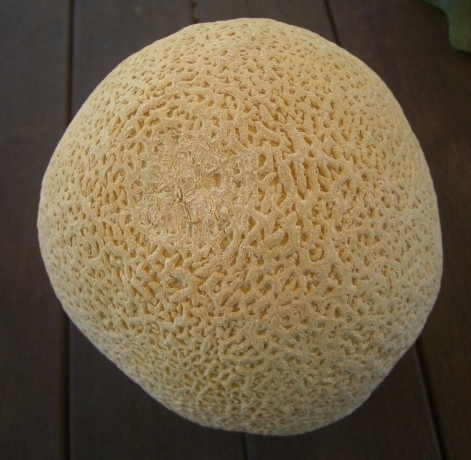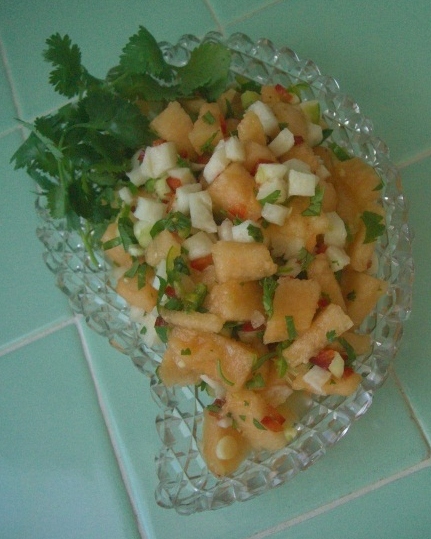
First things first: you know that ubiquitous greenish-orange round melon covered in a curious netted pattern that we've been calling a cantaloupe ever since we could handle three-syllable words? It is actually correctly identified as a muskmelon, not that our moms had ever even heard the word. A true cantaloupe, named after the Italian papal village of Cantalup, is mostly to be found only in Europe; it is heavily ribbed and lacks the distinctive surface webbing so familiar to melon-lovers here in the States.
Fortunately for those of us who savor the delights of sweet-fleshed melons, European varieties can occasionally be had these days at your local farmers market or health food emporium, and right now is high season for them. If you can find a Charentais, scoop it up immediately -- these small ambrosial melons are definitely one of the foods of the gods!
But your standard cantaloupe -- let's continue to give it that name, to avoid confusion and dissension in the ranks -- is no slacker. A Middle Eastern proverb puts it this way: "He who fills his stomach with melons is like he who fills it with light -- there is a blessing in them."
Blessings are indeed to be had in abundance from this delightful fruit that goes right to the head of the class. The U.S Department of Agriculture, in its Healthy Meals literature for schools, promotes the cantaloupe as a "good source of potassium, vitamin A and C." Vitamin A has been proven to be especially important for vision health, contributing to a reduced risk of cataracts and age-related macular degeneration. And a study at Kansas State University found that Vitamin A can help to offset the deleterious effects of second-hand smoke and to ward off emphysema.
Vitamin C, of course, is a powerful antioxidant; the Office of Dietary Supplements at the National Institutes of Health notes that "ongoing research is examining whether vitamin C, by limiting the damaging effects of free radicals through its antioxidant activity, might help prevent or delay the development of certain cancers, cardiovascular disease, and other diseases..." Not too shabby for something that can definitely satisfy the most demanding sweet tooth!
For maximum deliciousness and nutrition, be sure to choose the ripest melons you can find. They should be smooth and blemish-free, with no soggy spots; the underlying color should tend more to orange than to green; and the stem end should be smooth and slightly concave, with no pieces of stem still attached. When raised to your nose, the melon should give off a slight sweet fragrance (though an overpowering or cloying sweetness may indicate over-ripeness and interior decay).
Store whole melons in the crisper drawer of the fridge if possible -- the higher moisture level and colder temperature there is optimal.
Eaten out of hand, cut up on your cereal, pureed in a smoothie, folded into some yogurt or enjoyed in the recipes below -- be sure to indulge in this fragrant and felicitous fruit as often as possible!
A Word of Caution
Because cantaloupes grow on vines that allow them to rest on the soil, thorough cleaning and proper handling are especially important. That attractive raised webbing on the surface has its downside -- bacteria, including Salmonella and E. Coli find it an especially hospitable place to cling and hide.
The Division of Agriculture and Natural Resources at UC Davis recommends scrubbing the whole melon with a vegetable brush under running water, then blotting dry with a paper towel, to remove possible bacteria. Start with a clean cutting board and knife, and while cutting, be sure to rinse the knife repeatedly. Lastly, if not eating immediately, wrap the cut melon tightly and refrigerate immediately; this will help to inhibit the growth of bacteria.
Cantaloupe Salsa
Top a nice piece of grilled fish with this zesty salsa...
1 cup diced cantaloupe
1/3 cup diced jicama
2 tablespoons thinly sliced scallions
1 tablespoon minced red bell pepper
1 teaspoon minced fresh Serrano chile (optional)
1 tablespoon chopped cilantro
2 teaspoons fresh lemon juice
½ teaspoon sugar
Combine all ingredients, let sit for an hour or so.
Makes @ 1 ½ cups.
Cantaloupe & Watermelon Salad With Feta & Mint
A cool and refreshing side salad for a hot summer's day...
2 cups cubed cantaloupe (1-inch cubes)
2 cups cubed watermelon (same)
3 ounces crumbled French feta (I use Valbreso)
2 tablespoons chopped fresh mint leaves
2 tablespoons fresh lime juice
1 tablespoon safflower oil
1 teaspoon walnut oil
1 teaspoon honey
Toss cantaloupe and watermelon with chopped mint. Mound on a curved platter, scatter feta over the fruit.
Whisk together the lime juice, safflower oil, walnut oil & honey, then drizzle over fruit.
Serves six as a side dish.
[A version of this post appears in my "Eat Smart" column in the July issue of Better Nutrition Magazine.]


